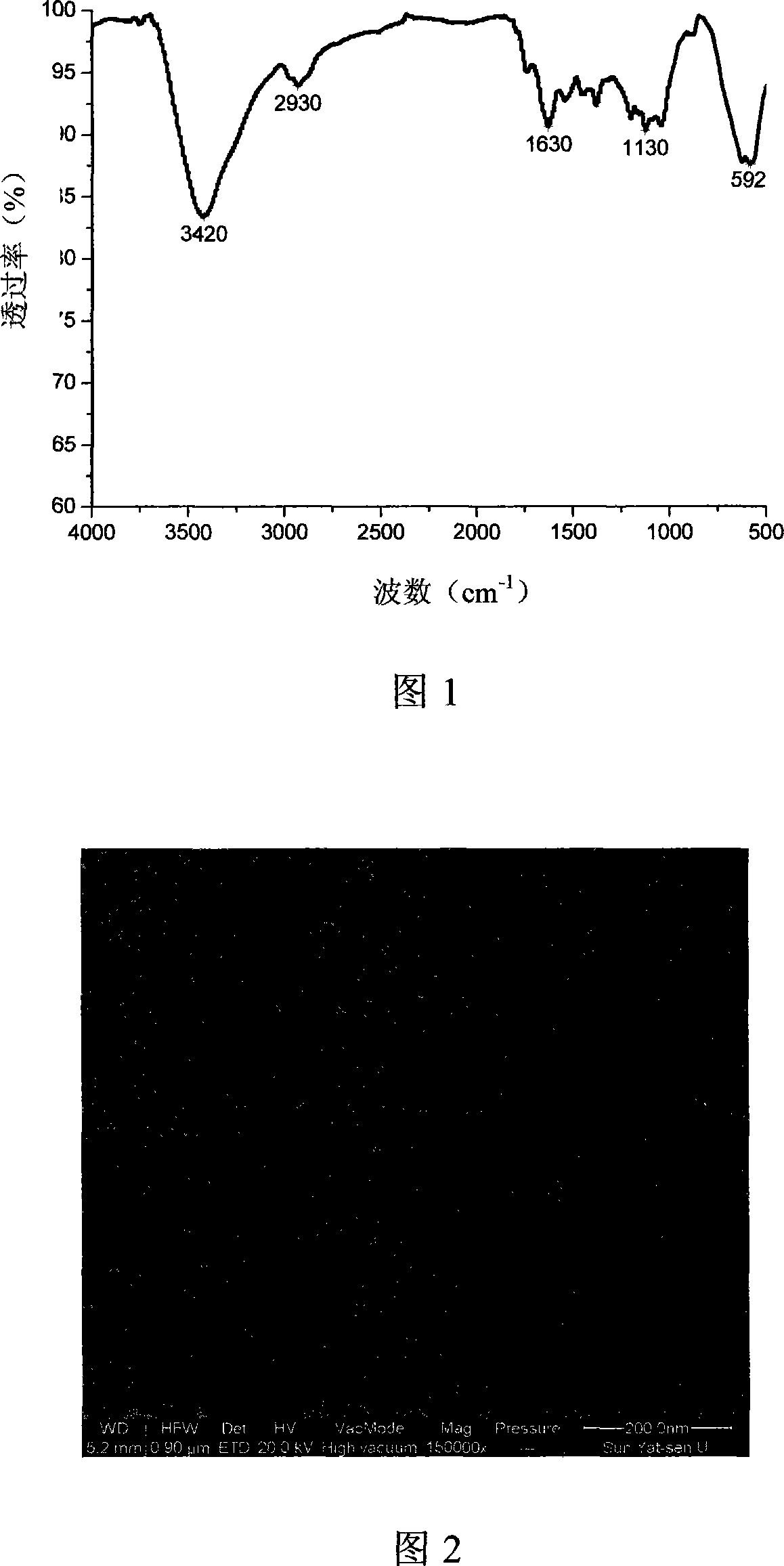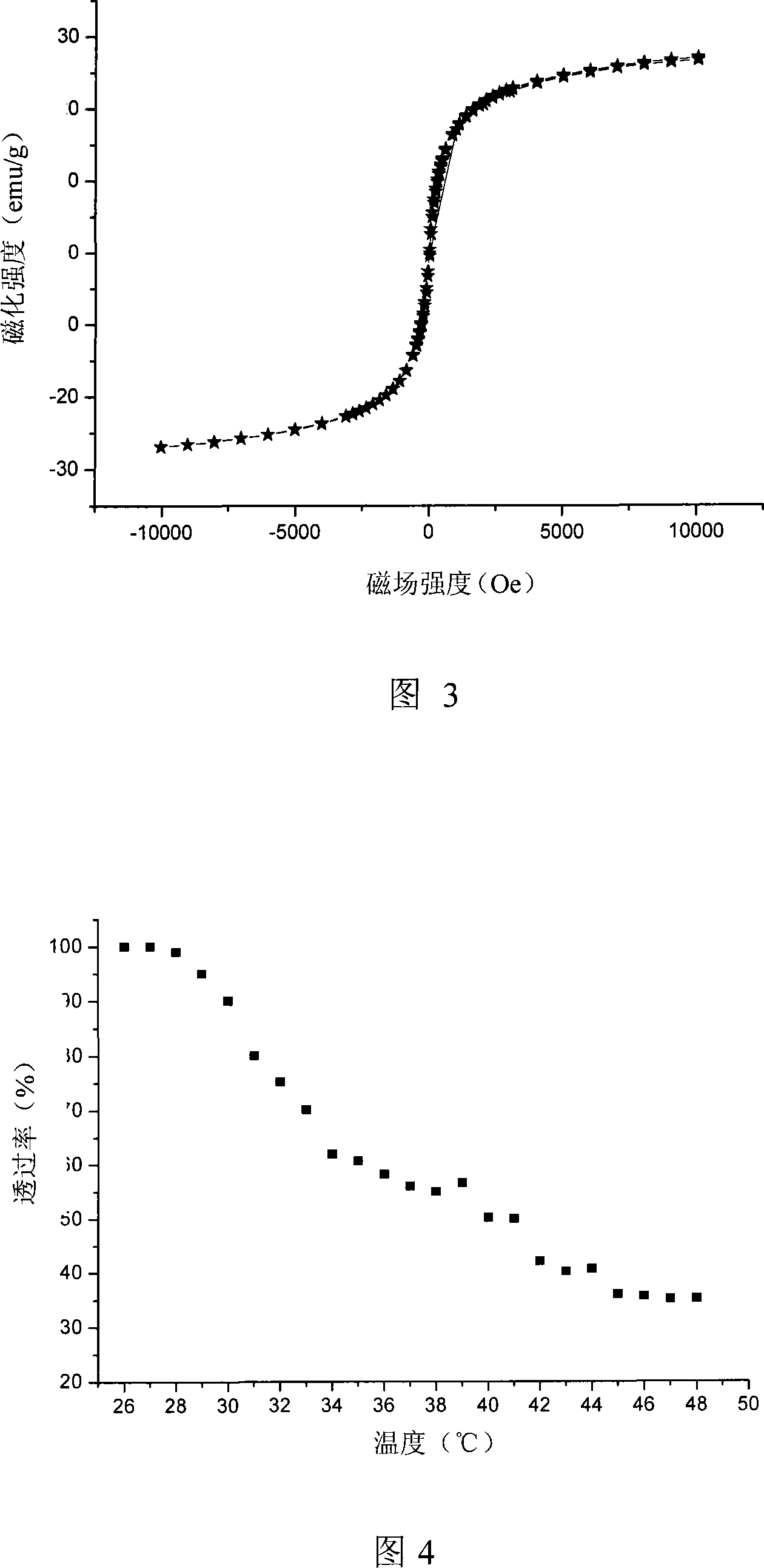Magnetic temperature sensing nano-particle with bioavailability and synthesizing method thereof
A biocompatibility and nanoparticle technology, applied in the field of magnetic temperature-sensitive nanoparticles and their synthesis, can solve the application limitations, magnetic temperature-sensitive nanoparticles are not biocompatible, and the magnetic response of magnetic microspheres is not too strong and other problems, to achieve the effect of simple and reliable synthesis method and strong magnetic response
- Summary
- Abstract
- Description
- Claims
- Application Information
AI Technical Summary
Problems solved by technology
Method used
Image
Examples
Embodiment 1
[0031] (1) Preparation of magnetic Fe 3 o 4 Nanoparticles: weigh 0.20g FeCl 2 4H 2 O and 0.50 g FeCl 3 ·6H 2 O, dissolved in 200mL distilled water at the same time, at 50°C, under the protection of nitrogen, add 4.0mol / L NaOH solution at one time, stir vigorously to make the system pH=11. Reaction at 80°C for 60 minutes, magnetic separation, the product was washed with distilled water several times to neutrality, and then dried in a vacuum oven at 60°C for 72 hours to obtain magnetic Fe 3 o 4 Nanoparticles;
[0032] (2) Magnetic Fe 3 o 4 Surface modification of nanoparticles: Weigh 0.2g magnetic Fe 3 o 4 Nanoparticles were added to 40mL of ethanol / distilled water with a volume ratio of 1:1 as the dispersion medium, and ultrasonically dispersed for 30min to remove the magnetic Fe. 3 o 4 Nanoparticle surface impurities. Magnetic Fe obtained after magnetic separation 3 o 4 Add ethanol / distilled aqueous solution (the volume ratio of ethanol and distilled water is 1:...
Embodiment 2
[0039] (1) Preparation of magnetic Fe 3 o 4 Nanoparticles: weigh 0.05g FeCl 2 4H 2 O and 0.15gFeCl 3 ·6H 2 O, dissolved in 200mL water at the same time, at 50°C, under the protection of nitrogen, add 4.5mol / L ammonia solution in one go, stir vigorously to make the system pH=12. Reaction at 75°C for 70 minutes, magnetic separation, the product was washed with deionized water several times to neutrality, and then dried in a vacuum oven at 60°C for 72 hours to obtain magnetic Fe 3 o 4 Nanoparticles;
[0040] (2) Magnetic Fe 3 o 4 Surface modification of nanoparticles: Weigh 0.3g magnetic Fe 3 o 4 Nanoparticles were added to 40mL of ethanol / distilled water with a volume ratio of 1:1 as the dispersion medium, and ultrasonically dispersed for 30min to remove the magnetic Fe. 3 o 4 Nanoparticle surface impurities. Magnetic Fe obtained after magnetic separation 3 o 4 Then add ethanol / distilled aqueous solution (the volume ratio of ethanol and distilled water is 1:1) to ...
Embodiment 3
[0044] (1) Preparation of magnetic Fe 3 o 4 Nanoparticles: weigh 0.10g FeCl 2 4H 2 O and 0.40 g FeCl 3 ·6H 2 O, dissolved in 200 mL water at the same time, at 55°C, under the protection of nitrogen, add 4.5mol / L NaOH solution at one time, stir vigorously to make the system pH=11. Reaction at 85°C for 40 minutes, magnetic separation, the product was washed with deionized water several times to neutrality, and then dried in a vacuum oven at 60°C for 72 hours to obtain magnetic Fe 3 o 4 Nanoparticles;
[0045] (2) Magnetic Fe 3 o 4 Surface modification of nanoparticles: Weigh 0.1g magnetic Fe 3 o 4 The nanoparticles were added to 40mL of methanol / water solution with a volume ratio of methanol to water of 1.2:1 as the dispersion medium, and ultrasonically dispersed for 30min to remove the magnetic Fe. 3 o 4 Nanoparticle surface impurities. Magnetic Fe obtained after magnetic separation 3 o 4 Then add methanol / water solution (the volume ratio of methanol to water is ...
PUM
| Property | Measurement | Unit |
|---|---|---|
| particle diameter | aaaaa | aaaaa |
| particle diameter | aaaaa | aaaaa |
| particle diameter | aaaaa | aaaaa |
Abstract
Description
Claims
Application Information
 Login to View More
Login to View More - R&D
- Intellectual Property
- Life Sciences
- Materials
- Tech Scout
- Unparalleled Data Quality
- Higher Quality Content
- 60% Fewer Hallucinations
Browse by: Latest US Patents, China's latest patents, Technical Efficacy Thesaurus, Application Domain, Technology Topic, Popular Technical Reports.
© 2025 PatSnap. All rights reserved.Legal|Privacy policy|Modern Slavery Act Transparency Statement|Sitemap|About US| Contact US: help@patsnap.com


